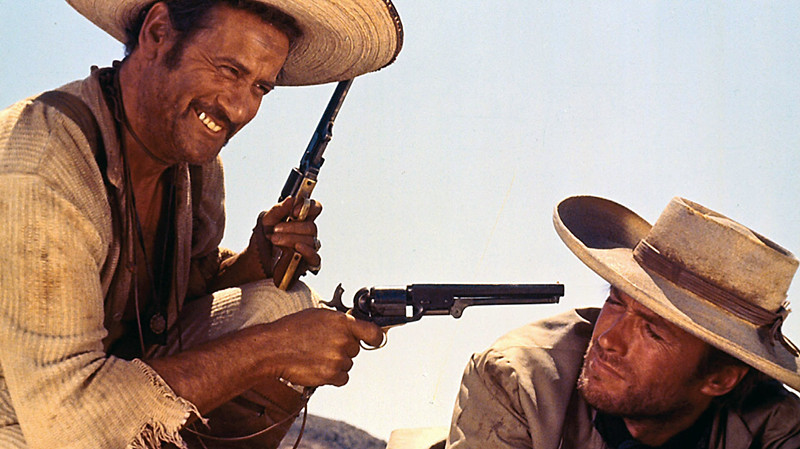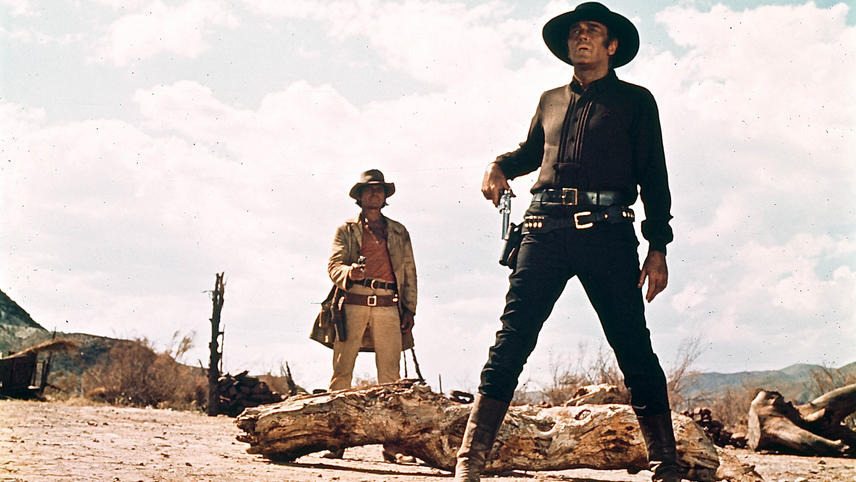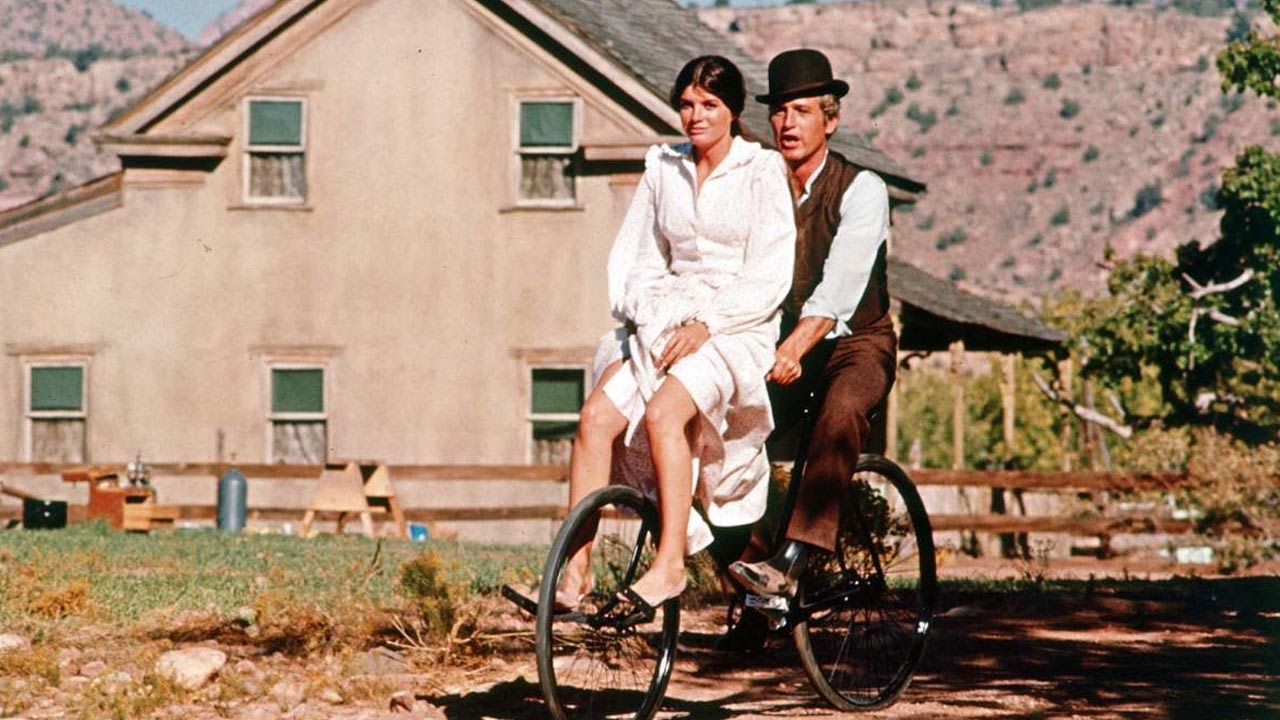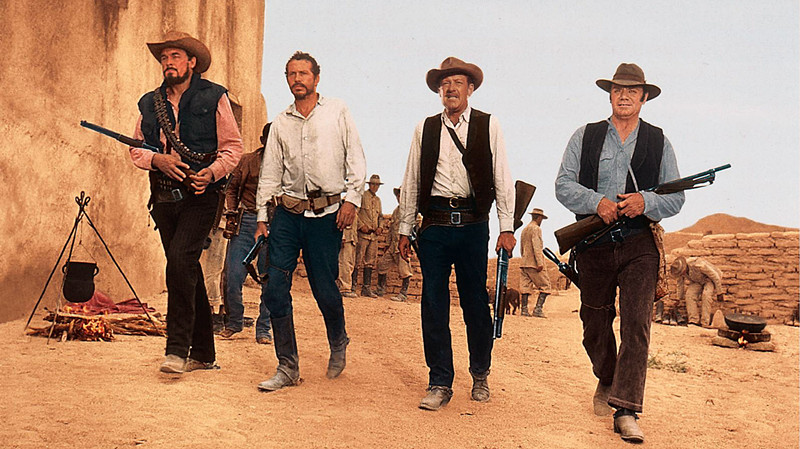6. The Good, the Bad and the Ugly (1966)

Will Ennio Morricone’s ‘The Ecstasy of Gold’ still be playing in a hundred years? Will the main theme, featuring coyote calls, yodelling, gunfire and whistling, still be remembered in two hundred years? The answer is yes – the music is so ingrained in the musical and cinematic halls of fame that it will be forever with us. Morricone might just be the mastermind behind The Good, the Bad and the Ugly; his compositions were written before filming and were then played on set to dictate the camera movements and editing.
The third and final film in the ‘Dollars’ trilogy, Leone’s glittering monument is a three-way treasure hunt between Clint Eastwood, Lee Van Cleef and Eli Wallach. The levels of distrust, even hatred, between the trio allows the story to glide with a smoothness that never once feels like its epic length. Leone’s editing reaches its zenith too; the Mexican standoff in the cemetery and the roaring of cannon fire in the brilliant Civil War sequence emerge as some of the best montages from the 1960s. The detail of Eastwood’s Blondie still looking over at Wallach’s Tuco during the standoff is one of those great observations upon second viewing, and every viewing after that.
It may be littered with enough iconic scenes to make other director’s envious, but The Good, the Bad and the Ugly also stars a wonderful consortium of small characters such as the gunshop owner, the alcoholic Captain Clinton, ‘Shorty’ and the hulking thug Tuco is chained to on the train. Exquisite.
7. Once Upon a Time in the West (1968)

Stepping away from the comic-book visuals and ironic humour of the Dollars films, Sergio Leone pivoted to making an elevated Western, one that would directly engage with the American Westerns. This was achieved in two essential ways: filming in America rather than in Europe, particularly in Monument Valley, the stomping ground of John Ford, and casting Henry Fonda, Hollywood’s moral compass, as the villainous Frank, introduced with the murder of a family.
A tapestry of stories form the film’s genre-encompassing narrative: the mysterious stranger looking for revenge (Charles Bronson’s Harmonica), the bandit with a good heart (Jason Robard’s Cheyenne), the prostitute looking to make a better life for herself (Claudia Cardinale), the Man in Black (Fonda), the coming of the railroad and the subsequent fall of the frontier to industrialisation.
Very little seems to happen in the film, with much of the first act being wordless. Blocked with precision and a keen eye for painterly images, each scene is written with an elegant poetry that feels concise. When Frank remarks he is not a businessman, just “a man,” Harmonica replies, “an ancient race.” Capitalism is coming and the frontier is vanishing.
The film’s fairytale title appears on the screen at the end, spinning upside down. Leone’s design is clear in how he wanted to tell a classic story but flipped it with the European stylings of his filmography.
8. Butch Cassidy and the Sundance Kid (1969)

Fondly remembered for the sizzling chemistry between Paul Newman and Robert Redford, Butch Cassidy and the Sundance Kid is a buddy film of the highest order. With a screenplay by the great William Goldman and cinematography by Conrad Hall that retains a fading sepia tone, the film is an elongated chase of two outlaws from the US right down to Bolivia.
It is hard to choose between Newman and Redford here, though the winner of the film must be director George Roy Hill who assembled all of these mighty talents and let them do their thing (he would also reteam with Newman and Redford for The Sting).
Butch Cassidy and the Sundance Kid’s freeze frame finale is renowned, and the tense buildup to it is palpable. The screenplay deceives in its way to find the humour and thrills of the story, but the unique visuals and that freeze frame finale ensure that this, like so many other 1960s Westerns, is a film about rethinking the frontier and determining what should and should not make the historical textbooks.
9. True Grit (1969)

It is often the case that a generation will grow up and prefer the remake to the original. Look no further than True Grit, which received the Coen brothers treatment in 2010 and is, to the younger viewer, a sleeker telling of the tale. The 1969 original does still have considerable merit, not least because its director, Henry Hathaway, had over 40 years of experience making Westerns when it came to adapting Charles Portis’ 1968 novel of the same name.
True Grit’s story is well known: Mattie, a young girl, hires the ageing, one-eyed Rooster Cogburn to track down the man who killed her father, Tom Chaney. Also included is Texas Ranger La Boeuf and the outlaw ‘Lucky’ Ned Pepper.
Assembling and disassembling notions of heroism and vigilantism, Hathaway also managed an impossible task: he got John Wayne an Oscar for Best Actor for playing Cogburn. It is Wayne’s most instantly recognisable performance, no thanks to the eye-patch, but this is definitely a ‘he is due an award’ performance rather than one for outright talent. A pre-fame Robert Duvall is enjoyable to watch but, much like Hailee Steinfield in the remake, it is Kim Darby as Mattie who manages to emerge from beneath the heavyweight shadows of her cast members like a budding flower poking around a wall. Wayne’s twilight hit its apex here.
10. The Wild Bunch (1969)

The recurring theme with the Western is that every director wants to make their definitive statement on the genre. There is something addictive to filmmakers about the Old West and its lawlessness; it represents the civilising of the unknown and the coming of a country’s great economic dominance. It also represents a moment of transition and evolution. Sam Peckinpah made many Westerns and many agree that The Wild Bunch is his best.
The film achieves a rare feat in that its traditional storyline of an outlaw gang on the run is given an American New Wave punch through its depiction of shocking violence and slow-motion sequences, all edited together in the two almighty shootouts that bookend the film in a sandwich of blood. It seems unlikely that the director of Ride the High Country in 1962 could have made something so visually shocking and divisive seven years later, but ‘Bloody Sam’ succeeded, setting a template for action that John Woo, Quentin Tarantino, Martin Scorsese and Zack Snyder would all end up referring to.
William Holden, a truly great leading man, plays Bishop, the head of the titular gang. Ernest Borgnine is his second in command and Robert Ryan plays Deke Thornton, a former friend who is now leading a posse of bounty hunters to eliminate the Wild Bunch. This chase storyline between former friends was recycled for Peckinpah’s Pat Garret and Billy the Kid, but he mastered it here as every flashback or moment of reflection for these men feels like a weary acknowledgement that the world is changing and they are struggling to change with it.
The film is notably set in 1912 and features such miracles of technology as the automobile and the machine gun to act as microcosms for this transition into the new, joyously juxtaposed with the perfect casting of an ageing William Holden. Like Clint Eastwood in Unforgiven, this is a man holding up a mirror and wondering how he can keep up in a changing industry, a changing world. Not all are able to adapt and those that do never quite feel the same. Only the children, introduced in the opening scene watching scorpions and ants duke it out, can grow into the world that the adults are dying for.